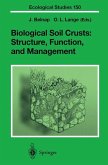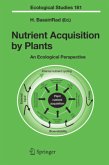In the course of evolution, a great variety of root systems have learned to overcome the many physical, biochemical and biological problems brought about by soil. This development has made them a fascinating object of scientific study.
This volume gives an overview of how roots have adapted to the soil environment and which roles they play in the soil ecosystem. The text describes the form and function of roots, their temporal and spatial distribution, and their turnover rate in various ecosystems. Subsequently, a physiological background is provided for basic functions, such as carbon acquisition, water and solute movement, and for their responses to three major abiotic stresses, i.e. hard soil structure, drought and flooding. The volume concludes with the interactions of roots with other organisms of the complex soil ecosystem, including symbiosis, competition, and the function of roots as a food source.
Hinweis: Dieser Artikel kann nur an eine deutsche Lieferadresse ausgeliefert werden.
This volume gives an overview of how roots have adapted to the soil environment and which roles they play in the soil ecosystem. The text describes the form and function of roots, their temporal and spatial distribution, and their turnover rate in various ecosystems. Subsequently, a physiological background is provided for basic functions, such as carbon acquisition, water and solute movement, and for their responses to three major abiotic stresses, i.e. hard soil structure, drought and flooding. The volume concludes with the interactions of roots with other organisms of the complex soil ecosystem, including symbiosis, competition, and the function of roots as a food source.
Hinweis: Dieser Artikel kann nur an eine deutsche Lieferadresse ausgeliefert werden.
From the reviews: "... As expected from the Ecological Studies series, the contributions are well-edited, up-to-date, concise and in-depth. As a summary of current knowledge of roots and how they do their job, this book deserves a place on all library shelves and will be of value to undergraduates writing essays through to those active in the research area." (Bulletin of the British Ecological Society) "This volume offers the reader a thorough grounding in several key areas of root ecology ... . The authors did a great job of identifying useful approaches and methods, including emerging technologies and applications. It is especially encouraging to read about the development and utilization of tools to observe roots and the rhizosphere with reduced disturbance. ... Root ecology offers an opportunity to learn about the innovations and developments occurring throughout this field." (Julie Whitbeck, Ecology, Vol. 85 (7), 2004) "The book starts with an overview of the form and function of roots and the problems that they encounter, followed by chapters on their spatial and temporal distribution. ... As expected from the Ecological Studies series, the contributions are well-edited, up-to-date, concise and in-depth. ... this book deserves a place on all library shelves and will be of value to undergraduates writing essays through to those active in the research area." (Bulletin of the British Ecological Society, Vol. 35 (1), 2004)








